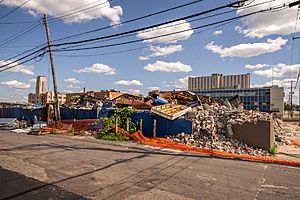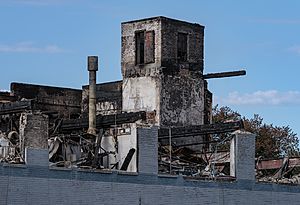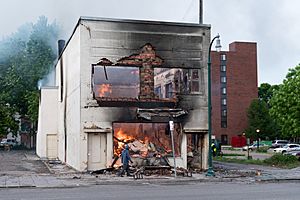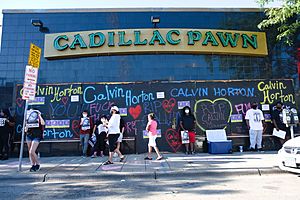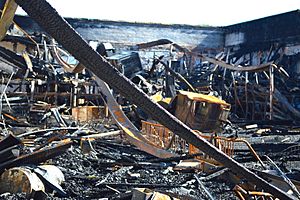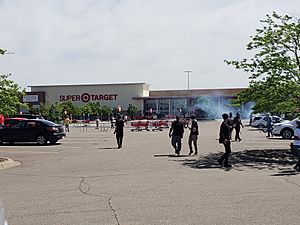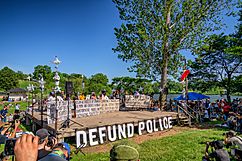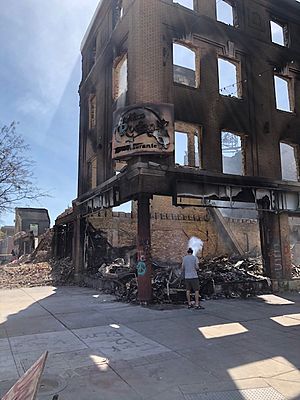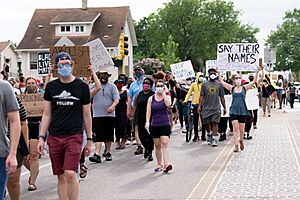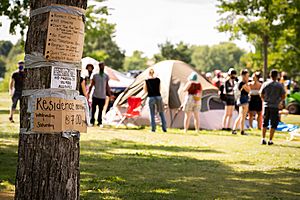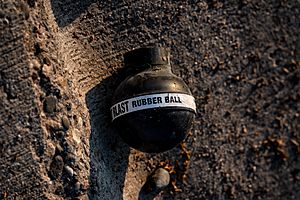Aftermath of the George Floyd protests in Minneapolis–Saint Paul facts for kids
Quick facts for kids Aftermath of the George Floyd protests in Minneapolis–Saint Paul |
|
|---|---|
| Part of George Floyd protests in Minneapolis–Saint Paul | |
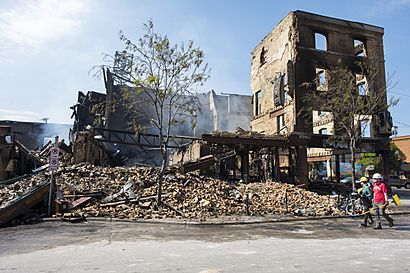
Ruins on East Lake Street, May 30, 2020
|
|
| Date | Initial period of unrest, May 26, 2020 – June 7, 2020 |
| Location | |
| Caused by | George Floyd protests |
| Methods | Riots, demonstrations, civil disobedience, civil resistance, public art |
| Status | Prolonged local unrest |
| Result | |
| Death(s) |
|
| Arrested | 604 from May 27, 2020—June 2, 2020 |
| Charged |
|
This article is about what happened after the George Floyd protests in Minneapolis–Saint Paul in the Twin Cities area of Minnesota. These events took place from May 26 to June 7, 2020. The protests started because of the death of George Floyd, a 46-year-old African-American man.
On May 25, 2020, a Minneapolis police officer, Derek Chauvin, knelt on Floyd's neck for over nine minutes during an arrest. Other officers were also there. A video of this incident was shared widely and caused a lot of anger.
People sometimes call these events the "2020 Minneapolis riots" or the "Minneapolis uprising." The first protests in Minneapolis on May 26, 2020, were peaceful. However, for three nights, from May 27 to May 29, there was a lot of unrest. This caused about $500 million in damage to 1,500 places. There were 604 arrests and 164 fires started on purpose. Sadly, two people also died.
Minnesota Governor Tim Walz sent in the state's National Guard to help calm things down. After May 30, 2020, the protests became mostly peaceful again. The events in Minneapolis and Saint Paul were very destructive, second only to the 1992 Los Angeles riots in U.S. history.
Contents
What Happened to Buildings and Businesses?
Fires, Damage, and Theft
After George Floyd's death, almost 1,500 buildings in the Twin Cities were damaged. Many were vandalized or robbed, and dozens were completely destroyed by fire. Some places were left as piles of rubble. People broke windows, spray-painted walls, and stole items from stores. Many stores were robbed more than once.
The worst damage in Minneapolis was along a 5-mile stretch of Lake Street. In Saint Paul, it was along a 3.5-mile part of University Avenue. During the unrest, the National Guard and police focused on protecting important places like the Federal Reserve and power plants. Officials later said this meant smaller, family-owned businesses were not as protected, and many were burned or robbed.
In Minneapolis, about 1,300 properties were damaged. Nearly 100 of these were destroyed or badly hurt. The total damage to properties was about $107 million. Overall, the city estimated losses of $350 million. Three post office buildings were destroyed by fire. Also, 35 families lost their homes in buildings that burned.
In Saint Paul, the damage was about $82 million, affecting 330 buildings. Thirty-seven properties were badly damaged or destroyed. Many of these were small businesses owned by people of color, including Asian-American people who had moved to the area after leaving war-torn countries.
| Type | Number damaged |
|---|---|
| Restaurant |
267
|
| Retail |
207
|
| Services |
114
|
| Grocery |
85
|
| Cellphone store |
76
|
| Fuel |
63
|
| Auto |
60
|
| Residence |
53
|
| Salon/barber |
52
|
| Health care |
47
|
Restaurants were the most damaged type of business, with 267 locations affected. Many restaurants were completely destroyed by fire. This included local places and fast-food chains like Arby's, Domino's Pizza, Popeyes, Subway, and Wendy's.
Damage also happened in nearby towns like Blaine, Apple Valley, Richfield, North Saint Paul, Maplewood, Brooklyn Center, and Roseville. The total damage in the region was over $500 million. This made it the second most destructive event in U.S. history, after the 1992 Los Angeles riots. Officials thought it could take 10 years to rebuild the damaged areas.
Rebuilding and Recovery Efforts
Life became harder for people and businesses in Minneapolis and Saint Paul after the unrest. Many local and minority-owned businesses were hit hard by both the COVID-19 pandemic and the damage. Private insurance covered less than half (about 40%) of the $500 million in damage. Many businesses did not have enough insurance to cover their losses.
Governor Walz asked the federal government for about $15 million to help with fire damage. However, President Donald Trump denied this request. He later said he denied the aid as "punishment" to local officials. This was different from how President George H. W. Bush helped Los Angeles after their riots in 1992.
State and local leaders promised to help affected businesses. In Saint Paul, the Chamber of Commerce raised $1 million for small business grants. Saint Paul also set up a $3 million relief fund, but it ran out quickly. The Lake Street Council in Minneapolis raised $12 million to help businesses rebuild in the East Lake Street area.
By August 2020, many damaged sites were still in ruins. The city of Minneapolis required businesses to pay property taxes before getting permits to tear down damaged buildings. This made it hard for owners to rebuild. Minneapolis later removed this tax rule.
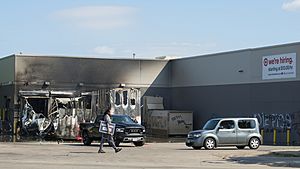
Some large businesses quickly announced plans to rebuild. Target Corporation rebuilt its store on East Lake Street, reopening it six months later in November 2020. Other nearby stores like Aldi, Family Dollar, and Cub Foods also reopened after repairs.
Many small business owners had to pay for repairs themselves because insurance didn't cover enough. A plan for a $300 million state recovery fund did not pass in 2020. In June 2021, lawmakers agreed to a $150 million relief program for small businesses. However, businesses had to match the funds they received. By the end of 2021, no business damaged in the unrest had received state aid.
The recovery for many small businesses near the third police precinct was slow. The owner of Gandhi Mahal Restaurant became famous for saying, "Let my building burn. Justice needs to be served." But six months later, he had to pay $80,000 for demolition himself. Demolition costs were often more than the buildings were worth before they burned.
Some businesses decided not to rebuild in Minneapolis. The 7-Sigma factory, which was badly damaged, left the city. The restaurant chain Arby's decided to wait to rebuild its East Lake Street location, worried about future unrest.
About a year after the May 2020 events, less than 5% of damaged businesses on East Lake Street had reopened. In Saint Paul, 35 of 270 damaged businesses were still closed. The Midway Shopping Center in Saint Paul was permanently closed and torn down. This forced several minority-owned businesses inside to close, even if their storefronts weren't burned.
People Who Died
Calvin Horton Jr.
Calvin Horton Jr., a 43-year-old man, was shot and killed on May 27, 2020. This happened near the Cadillac Pawn & Jewelry shop. The shop owner shot him, believing Horton was robbing his business. The area was very chaotic.
When police arrived, people threw objects at them. Paramedics couldn't reach Horton right away. He died later at a hospital. The shop owner was arrested but later released because there wasn't enough evidence to prove it wasn't self-defense. The gun and surveillance videos were gone because the store was robbed.
Oscar Lee Stewart Jr.
Oscar Lee Stewart Jr., 30, died on May 28, 2020, in a fire at the Max It Pawn shop in Minneapolis. His body was found in July, and his identity was confirmed in October. Officials said he died from breathing in smoke and heat from an intentional fire.
Montez T. Lee Jr. was charged with setting this fire. Stewart had told his family he was going to see the protests on Lake Street. He never came home. Videos from that night showed people trying to rescue someone trapped inside the burning pawn shop. The cries for help stopped before firefighters could get in.
In July 2021, Montez T. Lee Jr. pleaded guilty to setting the fire. He poured a liquid around the business and set it on fire. His lawyer said Lee believed the pawn shop was empty when he started the fire. Prosecutors asked for a lighter sentence, saying they didn't think he meant to hurt anyone.
Outside Groups and Extremists
Early Ideas and Investigations
At first, state and local officials thought "white supremacists" and "outside agitators" were causing the damage. Governor Walz thought 80% of those causing destruction were from outside Minnesota. However, later studies of arrests showed that less than 20% were from outside the state.
President Donald Trump and Attorney General William Barr blamed groups like Antifa. But an FBI investigation found no such trend among those responsible. The FBI believed most damage was caused by large, unplanned crowds, not by extremist groups. However, some white supremacist groups did talk about using the events to cause racial violence.
"Umbrella Man"
A person nicknamed "Umbrella Man" was seen in a video on May 27, 2020. He wore black clothes, a gas mask, and carried an umbrella and a small sledgehammer. He broke windows at an AutoZone store and spray-painted it. He also threatened a photojournalist. Later that day, the AutoZone store was set on fire.
In July 2020, Minneapolis police identified a suspect for "Umbrella Man." He had connections to groups like the Hells Angels and Aryan Cowboy Brotherhood, which are known for white supremacist views. Police documents said these groups discussed pretending to be protesters to cause trouble. The suspect had not been charged as of December 2020.
Boogaloo Movement
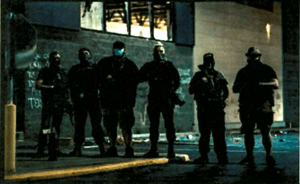
Members of the Boogaloo movement, a far-right group that wants a civil war, discussed how to cause more chaos during the unrest. They hoped the chaos would be blamed on the Black Lives Matter movement. Three Boogaloo members were later found guilty of federal crimes related to the violence in Minneapolis.
These individuals were Michael Robert Solomon, Benjamin Ryan Teeter, and Ivan Harrison Hunter. They were seen carrying guns and talked about attacking police to start a government overthrow. Solomon and Teeter later tried to buy weapons from an FBI informant they thought was part of Hamas. They also planned to bomb a courthouse. They were arrested in September 2020 and pleaded guilty to terrorism charges.
Ivan Harrison Hunter was charged for shooting 13 times into the Minneapolis third police precinct building with an AK-47-style gun. People were inside the building, looting it, and setting it on fire. Hunter traveled from Texas to cause damage. He bragged about his role on Facebook. He pleaded guilty in September 2021 and was sentenced to four years in prison.
Hackers and Online Attacks
The City of Minneapolis saw more cyberattacks after George Floyd's death. These attacks were often from "hacktivist" groups. There was an increase in ransomware and malware. Hackers also caused temporary outages for Minnesota's emergency systems by using denial of service attacks.
Immediate Changes and Effects
Police Policies
The Minneapolis police faced a lot of criticism. In June, the Minneapolis City Council and the Minnesota Department of Human Rights ordered the police to ban chokeholds and neck restraints. Many organizations, like the city's school district and University of Minnesota, ended their formal ties with the police.
The Minnesota state legislature passed new laws in July. These laws banned chokeholds, created a group to review police-related deaths, and required de-escalation training for officers. By late 2020, the city planned to start programs for mental health response teams and violence prevention. They also looked at limiting no-knock warrants and making police use-of-force rules clearer.
On June 7, 2020, nine Minneapolis city council members publicly promised to dismantle the police department. This idea meant thinking about unarmed crisis response teams and using the police budget for education, housing, and health care instead. However, the city's police force was not actually disbanded.
In December 2020, the city council voted to move $7.7 million from the police budget to mental health teams and violence prevention. They also put $11.4 million in a reserve fund for police hiring and overtime. The council voted to keep the police department's target number of officers at 888. This change was not as big as some activists wanted.
Bob Kroll, the head of the Minneapolis police union, was criticized. He sent an email calling the protests a "terrorist movement." Many local officials and union leaders condemned his statement. In November 2021, Minneapolis voters rejected a plan to replace the police department with a new public safety department. By the end of 2021, police funding in Minneapolis was almost back to its original level.
Monuments and Names Changed
After George Floyd's death, many protests focused on removing statues and memorials with controversial histories. On June 10, 2020, a statue of Christopher Columbus at the Minnesota State Capitol was torn down by American Indian Movement protesters. The Minnesota Twins baseball team removed a statue of their former owner, Calvin Griffith, on June 19, 2020.
Residents in the East Calhoun neighborhood of Minneapolis pushed to rename it because of John C. Calhoun's history of defending slavery. In July 2021, it was renamed East Bde Maka Ska. In 2022, Dight Avenue was renamed Cheatham Avenue, honoring John Cheatham, one of the city's first Black firefighters.
Politics and Elections
Most protests after George Floyd's death were peaceful. Some protesters even tried to stop the destruction. But for others, the damage was seen as an understandable reaction to years of unfairness and lack of police reform. The events in Minneapolis became a big topic for politicians.
The civil rights movement after Floyd's death, along with the COVID-19 pandemic, led to more people registering to vote in 2020. In Minnesota, more Democrats registered, while Republican registration stayed the same. Young people of color felt they could push for changes to address racism in schools. Social justice groups also received more donations.
There was talk that the unrest could change election results in Minnesota. Images of the fires in Minneapolis were used in political ads for President Donald Trump's re-election campaign. These ads suggested voting against Joe Biden, even though Biden did not support defunding the police. Biden won Minnesota by a larger margin than Hillary Clinton did in 2016. His biggest gains were in the Minneapolis–Saint Paul suburbs.
Some people who participated in the protests later ran for public office. On November 2, 2021, Minneapolis voters reelected Mayor Frey. They also rejected the idea of replacing the police department with a new public safety department.
COVID-19 Pandemic
The protests happened during the global COVID-19 pandemic. Many protesters wore masks, but social distancing was hard in large crowds. People had to decide if the risk of getting sick was worth protesting for police accountability. Health officials warned that large protests could spread the virus, especially in minority communities.
In early June 2020, the Minnesota Department of Health offered free testing clinics for protesters. By June 18, 2020, only 1.8% of people tested at four sites who attended protests tested positive for the virus. A health official said that the protests were not a major source of virus spread.
Homeless Camps
The unrest affected people experiencing homelessness. About 200 homeless people found shelter in a closed Sheraton hotel. However, the situation became chaotic with damage and violence. These people were later evicted and some set up a camp at Powderhorn Park, which grew to about 800 people by mid-July 2020.
The Minneapolis Park and Recreation Board cleared the park in late July. They then decided to allow homeless camps in up to 20 city parks, with up to 25 tents each. But the situation quickly grew out of control, with unpermitted camps spreading to 40 parks. These permitted camps lasted until January 7, 2021. Sadly, four people died in these camps between June 2020 and January 2021.
Investigations and Lawsuits
Police Actions
Some protesters and journalists said the Minneapolis police used too much force. Two police officers faced disciplinary actions. One was for talking to a reporter about problems in the police department. Another was for not reporting that they hit two people with rubber bullets. About 550 complaints were filed against police for using tactics like tear gas and rubber bullets on peaceful protesters.
The United States Justice Department started an investigation into the City of Minneapolis and its police department in April 2021. They looked into whether police used too much force against people who were exercising their right to protest.
Lawsuit Payments
The City of Minneapolis faced $111 million in legal costs from the weeks after George Floyd's death. Most of this was from 13 claims of police misconduct during the protests. The city paid $2.4 million to a protester who lost his right eye after being hit by a rubber bullet. The city also paid $900,000 each to two women who were hit in the face by police projectiles, even though they were not involved in violence.
By March 2022, the city had settled three smaller lawsuits and five more were still pending. The city also had to pay $20 million in workers' compensation for 15 police employees who experienced post-traumatic stress disorder in 2020.
Reports on What Happened
In October 2020, Minnesota Senate Republicans released a report. It blamed Governor Walz and Mayor Frey for not doing enough to stop the unrest. This report was based on news stories and social media. Democratic Senators criticized the report for not mentioning Derek Chauvin or the community's distrust of the police as reasons for the anger.
The City of Minneapolis and the State of Minnesota also ordered their own reports on the emergency response. These reports, released in early 2022, both found similar problems. They said officials didn't follow emergency rules and were slow to coordinate their response to the looting and fires. They also criticized police for firing less-lethal weapons and tear gas at protesters without checking if they were being violent.
News Coverage
The documentary Say His Name: Five Days for George Floyd, released in 2021, showed footage of the protests and unrest. The director, Cy Dodson, lived in the area and filmed what he saw. The Minneapolis-based Star Tribune newspaper won a Pulitzer Prize in 2021 for its reporting on George Floyd's death and what happened afterward. Darnella Frazier, who was 17 at the time, filmed Floyd's arrest on her cellphone. She also received a special Pulitzer recognition in 2021 for her video.
Maps
Major areas of civic unrest in Minneapolis and Saint Paul, May 27–29, 2020:


